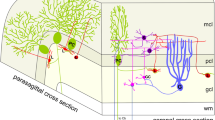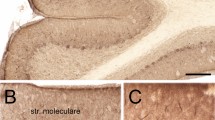Summary
The appearance and distribution of the calciumbinding protein parvalbumin was investigated immunocytochemically at different postnatal developmental stages of the zebra finch cerebellum. Purkinje, basket and stellate, but not granule neurons or glial cells were labeled by an antiserum against chicken parvalbumin. At all developmental stages investigated immunostained Purkinje cells were found in clusters separated by spaces containing unstained large cells, probably Purkinje and Golgi type-II cells, and unstained smaller cells resembling granule neurons. Perisomatic processes, dendrites and spines of Purkinje cells were heavily immunoreactive. Axons of Purkinje cells were observed to be parvalbumin-positive throughout their entire length until developmental stage D 24, i.e., 10 days after hatching. Their immunoreactivity gradually decreased up to adulthood, when only their proximal portions, in addition to a few punctate structures in the internal granular layer and in the deep cerebellar nuclei presumably representing the synaptic terminals, remained immunoreactive. This decrease in immunoreactivity might be related to progressive maturation and/or degree of myelination. The developmental expression of parvalbumin immunoreactivity and its ultrastructural localization in spines, postsynaptic densities and on microtubular elements leads to several suggestions concerning the possible function of parvalbumin in neurons. In outgrowing dendrites and axons the protein might be involved in the regulation of the synthesis of membrane components, their intracellular transport and fusion of new membrane components into the plasmalemma, events that are Ca- and/or Mg-dependent. In spines and postsynaptic densities parvalbumin might be involved in the development and regulation of synaptic activities in Ca-spiking elements such as the inhibitory Purkinje cells, and possibly also in stellate and basket cells. Furthermore, in developing and adult neurons parvalbumin might be involved in the Ca-/Mg-regulation of a variety of enzymatic activities and hence influence the alteration of the intracellular metabolic potential in response to extracellular signals.
Similar content being viewed by others
References
Altman J (1972) Postnatal development of the cerebellar cortex in the rat. II. Phases in the maturation of Purkinje cells and of the molecular layer. J Comp Neurol 145:399–464
Altman J (1982) Morphological development of the rat cerebellum and some of its mechanisms. In: Palay SL, Chan-Palay V (eds) The cerebellum-New vistas. Exp Brain Res Suppl 6. Springer, Berlin, Heidelberg, New York, pp 8–46
Baimbridge KG, Miller JJ (1982) Immunohistochemical localization of calcium-binding protein in the cerebellum, hippocampal formation and olfactory bulb of the rat. Brain Res 245:223–229
Berchtold MW, Wilson KJ, Heizmann CW (1982) Isolation of neuronal parvalbumin by high-performance liquid chromatography. Characterization and comparison with muscle parvalbumin. Biochemistry 21:6552–6557
Berchtold MW, Celio MR, Heizmann CW (1985) Parvalbumin in human brain. J Neurochem (in press)
Braun K, Scheich H, Schachner M, Heizmann CW (1985 a) Distribution of parvalbumin, cytochrome oxidase activity and 14C-2-deoxyglucose uptake in the brain of the zebra finch. I. Auditory and vocal motor systems. Cell Tissue Res 240:101–115
Braun K, Scheich H, Schachner M, Heizmann CW (1985 b) Distribution of parvalbumin, cytochrome oxidase activity and 14C-2-deoxyglucose uptake in the brain of the zebra finch. II. Visual system. Cell Tissue Res 240:117–127
Bygrave FL (1976) Cellular calcium and magnesium metabolism. In: Williams DR (ed) An introduction to bio-inorganic chemistry. Charles C Thomas Springfield Ill, pp 171–184
Carafoli E, Crompton M (1978) The regulation of intracellular calcium. In: Bronner F, Kleinzeller A (eds) Current topics in membranes and transport vol 10. Academic Press, New York, San Francisco, London, pp 151–216
Celio MR, Heizmann CW (1981) Calcium-binding protein parvalbumin as a neuronal marker. Nature 293:300–302
Celio MR, Heizmann CW (1982) Calcium-binding protein parvalbumin is associated with fast contracting muscle fibres. Nature 297:504–506
Chan SY, Ochs S, Worth RM (1980) The requirement for calcium ions and the effect of other ions on axoplasmic transport in mammalian nerve. J Physiol 301:477–504
Crescitelli F (1951) Nerve sheath as a barrier to the action of certain substances. Am J Physiol 166:229–240
DeCamilli P, Miller PE, Levitt P, Walter U, Greengard P (1984) Anatomy of cerebellar Purkinje cells in the rat determined by a specific immunohistochemical marker. Neuroscience 11 (4):761–817
Fifkova E, Markham JA, Delay RJ (1983) Calcium in the spine apparatus of dendritic spines in the dentate molecular layer. Brain Res 266:163–168
Garcia-Segura LM, Baetens D, Roth J, Norman AW, Orci L (1984) Immunohistochemical mapping of Calcium-binding protein immunoreactivity in the rat central nervous system. Brain Res 296:75–86
Garson JA, Beverley PLL, Coakham HB, Harper EJ (1982) Monoclonal antibodies against human T-lymphocytes label Purkinje cell neurones of many species. Nature 298:375–377
Gerday Ch (1982) Soluble calcium-binding proteins from fish and invertebrate muscle. Molec Physiol 2:63–87
Heizmann CW (1984) Parvalbumin, an intracellular calcium-binding protein: distribution, properties and possible roles in mammalian cells. Experientia 40:910–921
Heizmann CW, Strehler EE (1979) Chicken parvalbumin. Comparison with parvalbumin-like protein and three other components (Mr=8,000–13,000). J Biol Chem 254:4296–4303
Jande SS, Maler L, Lawson DEM (1981) Immunohistochmical mapping of vitamin D-dependent calcium-binding protein in brain. Nature 296:765–767
Katz B, Miledi R (1965) The effect of calcium on acetylcholine release from motor nerve terminals. Proc Roy Soc (London) 161:496–503
Koschennikoff A (1869) Axencylinderfortsatz der Nervenzellen im Kleinen Hirn des Kalbes. Arch f Mikr Anat Bd 5:332–333
Kretsinger RH (1980) Structure and evolution of calcium-modulated proteins. CRC Crit Rev Biochem 8:114–174
Krnjevic K (1955) The distribution of Na and K in cat nerves. J Physiol 128:473–488
Legrand Ch, Thomasset M, Parkes CO, Clavel MC, Rabie A (1983) Calcium-binding protein in the developing rat cerebellum. Cell Tissue Res 233:389–402
Lehninger A (1975) Biochemistry. Worth Publ Inc New York
Llinas R (1975) Electroresponsive properties of dendrites in central neurons. In: Kreutzberg GE (ed) Advances in neurology. Raven Press, New York, pp 1–13
Llinas R (1979) The role of calcium in neuronal function. In: Schmitt FO, Worden FG (eds) The neurosciences, Fourth Study Program. MIT Press Cambridge, Massachusetts and London, pp 555–571
Llinas R, Hess R (1976) Tetrodotoxin-resistant dendritic spikes in avian Purkinje cells. Proc Natl Acad Sci USA 73:2520–2523
Mallet J, Huchet M, Pugeois R (1976) Anatomical, physiological and biochemical studies on the cerebellum from mutant mice. III. Protein differences associated with the weaver, staggerer and nervous mutant mice. Brain Res 103:291–312
Mallet J, Christen R, Changeux JP (1979) Immunological studies on the Purkinje cells from rat and mouse cerebella. I. Evidence for antibodies characteristic of the Purkinje cells. Dev Biol 72:308–319
Means AR, Dedman JR (1980) Calmodulin — an intracellular calcium receptor. Nature 285:73–77
Miale JL, Sidman RL (1961) An autoradiographic analysis of histogenesis in the mouse cerebellum. Exp Neurol 4:227–296
Mugnaini E (1969) Ultrastructural studies on the cerebellar histogenesis. II. Maturation of nerve cell populations and establishment of synaptic connections in the cerebellar cortex of the chick. In: Llinas (ed) Neurobiology of cerebellar evolution and development. Proc of the First Internat Sympos of the Inst for Biomed Res Am Med Assoc/Educ and Res Found, pp 749–782
Müntener M, Berchtold MW, Heizmann CW (1985) Parvalbumin in cross-reinnervated and denervated muscles. Muscle Nerve 8:132–137
Nairn AC, Greengard P (1983) Cyclic GMP-dependent protein phosphorylation in mammalian brain. Fed Proc 42:3107–3113
Ochs S, Worth RN, Chan SY (1977) Calcium requirement for axoplasmic transport in mammalian nerve. Nature 270:748–750
Pfyffer GE, Bologa L, Herschkowitz N, Heizmann CW (1984) Parvalbumin, a neuronal protein in brain cell cultures. J Neurochem 43:49–57
Reeber A, Vincendon G, Zanetta JP (1981) Isolation and immunohistochemical localization of a “Purkinje cell specific glycoprotein subunit” from rat cerebellum. Brain Res 229:53–65
Roth J, Baetens D, Norman AW, Garcia-Segura L-M (1981) Specific neurons in chick central nervous system stain with an antibody against chick intestinal vitamin D-dependent calciumbinding protein. Brain Res 222:452–457
Schneeberger PR, Norman AW, Heizmann CW (1985) Parvalbumin and vitamin D-dependent calcium-binding protein (Mr=28K): comparison of their localization in the cerebellum of normal and rachitic rats. Neurosci Lett (in press)
Seto-Ohshima A, Kitajima S, Sano M, Kato K, Mizutani A (1983) Immunohistochemical localization of calmodulin in mouse brain. Histochemistry 79:251–257
Seto-Ohshima A, Keino H, Kitajima S, Sano M, Mizutani A (1984) Developmental change of the immunoreactivity to anti-calmodulin antibody in the mouse brain. Acta Histochem Cytochem 17:109–117
Strehler EE, Eppenberger HM, Heizmann CW (1977) Isolation and characterization of parvalbumin from chicken leg muscle. FEBS-Lett 78:127–133
Voogd J (1969) The importance of fiber connections in the comparative anatomy of the mammalian cerebellum. In: Llinas (ed) Neurobiology of cerebellar evolution and development. Proc of the First Internat Sympos of the Inst for Biomed Res Am Med Assoc/Educ and Res Found, pp 413–514
Wassef M, Zanetta JP, Brehier A, Sotelo C (1985) Transient biochemical compartmentalization of Purkinje cells during early cerebellar development. Dev Biol (in press)
Weber A, Schachner M (1982) Development and expression of cytoplasmic antigens in Purkinje cells recognized by monoclonal antibodies. Cell Tissue Res 227:659–676
Weber A, Schachner M (1984) Maintenance of immunologically identified Purkinje cells from mouse cerebellum in monolayer culture. Brain Res 311:119–130
Wnuk W, Cox JA, Stein EA (1982) Parvalbumins and other soluble high-affinity calcium-binding proteins from muscle. In: Cheung WY (ed) Calcium and cell function Vol 11. Academic Press New York, London pp 243–278
Woodward DJ, Hoffer BJ, Lapham LW (1969) Correlative survey of electrophysiological, neuropharmacological and histochemical aspects of cerebellar maturation in rat. In: Llinas (ed) Neurobiology of cerebellar evolution and development. Proc First Internat Sympos of the Inst Biomed Res Am Med Assoc/Educ and Res Found, pp 725–741
Zuschratter W, Scheich H, Heizmann CW (1985) Ultrastructural localization of the calcium-binding protein parvalbumin in neurons of the song system of the zebra finch. Cell Tissue Res 241:77–83
Author information
Authors and Affiliations
Additional information
This work was supported by the Deutsche Forschungsgemeinschaft, SPP “Verhaltensontogenie” and by the Swiss National Science Foundation, Grant No. 3.185-0.82
Rights and permissions
About this article
Cite this article
Braun, K., Schachner, M., Scheich, H. et al. Cellular localization of the Ca2+-binding protein parvalbumin in the developing avian cerebellum. Cell Tissue Res. 243, 69–78 (1986). https://doi.org/10.1007/BF00221854
Accepted:
Issue Date:
DOI: https://doi.org/10.1007/BF00221854




